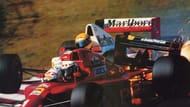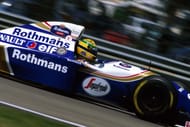In 1991, instead of Prost, Nigel Mansell’s Williams proved a serious threat for the title to Senna, but he managed to keep the challenge at bay and became the youngest three-time world champion at the time. In the succeeding two seasons, in 1992 and in 1993, Senna’s McLaren proved to be less competitive than the ever improving Williams. The higher technical superiority of the Williams with advantages like traction control gave an edge to its drivers against others, which helped Mansell to finally achieve a well deserved world title and the in the following year, Prost won his fourth and final title with the team before retiring.
Senna was known to be ruthless and had a concrete will for winning as evidenced by his actions at the 1988 Portuguese Grand Prix, where he almost ran his teammate Alain Prost into the pit wall, and also the 1990 Japanese Grand Prix where he intentionally collided with Prost to win the championship. In an interview with Jackie Stewart in 1990, where Stewart questioned him relating to his controversial collisions in the past few years, Senna had replied thus:
“By being a racing driver you are under risk all the time. By being a racing driver means you are racing with other people. And if you no longer go for a gap that exists, you are no longer a racing driver because we are competing, we are competing to win. And the main motivation to all of us is to compete for victory, it’s not to come 3rd, 4th, 5th or 6th. I race to win as long as I feel it’s possible. Sometimes you get it wrong? Sure, it’s impossible to get it right all the time. But I race designed to win, as long as I feel I’m doing it right.”
But besides this, and in stark contrast to his ruthless attitude during racing, Senna was a devout Catholic and was known to be warm and humble. This further came to light during the qualifying session for the Belgian Grand Prix, where French driver Erik Comas had crashed out on the track. Senna, who was the first one who arrived on the scene, came out of the car to help him.
1993 also bore witness to another of Senna’s spectacular driving displays in the rain at the European Grand Prix at Donington Park, United Kingdom. That year, Senna’s car proved no match to the Williams, but under rainy conditions, he skillfully mastered all others on the grid. In the race, Senna didn’t have a good start and dropped from 4th to 5th and as the race progressed, Senna passed Schumacher, Wendlinger, then Hill and finally Prost at the final corner of the lap to take the lead. Thus, Senna masterfully outclassed his rivals and went unbelievably from 5th to 1st within a single lap. This kind of performance was not an occasional display, but he was consistently on the limit and it came to clearer interpretations only during mixed conditions.
Senna had earlier said that when he was young he couldn’t handle the kart during rains. Thus frustrated by it, he had practiced under such conditions until he had totally mastered it. Similar kind of performances under such conditions were also given by him in races like the 1984 Monaco Grand Prix, where he finished second in an inferior car and also at the 1985 Portuguese Grand Prix, his first victory, where he lapped the entire field barring Michele Alboreto in second place.
In 1994, Senna finally signed for Williams hoping to be in a much more competitive car. But because of the rule changes, the technical advantages which the Williams had enjoyed over the previous years had declined, due to which the car had become difficult to drive. Senna himself had complained about the condition of the car on several occasions. In the first two races of the season, Senna though on pole, retired from both the races. At the third race of the season in Imola, Italy, Senna was again on pole, but the race weekend was marred by the death of Roland Ratzenberger in qualifying on Saturday and also Rubens Barrichello on Friday had luckily survived a huge crash.
Sid Watkins, medical chief at F1 races and close friend of Senna, had after the tragic events of the previous days asked him
“You know Ayrton, you’ve been 3 times world champion, you’re the fastest man in the world, and you like fishing, so, why don’t you quit, and i’ll quit and we’ll just go fishing.”
But Senna had replied, “Sid. I can’t quit.”
The race began on Sunday, that is 1st May, 1994, amidst gloom surrounding the atmosphere. At the start, JJ Lehto’s Benetton stalled and was hit by Pedro Lamy’s Lotus from behind. This incident brought out the safety car which remained till lap 6. When the race resumed Senna led from Schumacher, and as he approached the high speed Tambulrello corner on Lap 7, his car left the racing line, ran in a straight line off the track and slammed into an unprotected concrete barrier.
From the accident, Senna suffered serious brain and skull injuries and ruptured arteries which proved fatal. Later, it was also found out that Senna had kept an Austrian flag in his cockpit, which he had intended to unfurl at the end of the race in honor of Roland Ratzenberger.
After Senna’s death, there was a huge uproar around the world relating to safety in Formula 1, which prompted the FIA to introduce major changes which helped improve safety in the sport.
The following improvements have been made since:
1. Helmets have been made stronger and are tested to endure high impacts, the use of removable strips on the visor has been introduced and also Hand and Neck Support (HANS) has also been made compulsory.
2. Cars now have to go through tough crash tests in order to ensure safety.
3. The medical facilities and staff have been updated, now medical help can reach drivers within 30 seconds of any accident.
4. The track designs have been altered, like runoff areas have been introduced at high speed corners.
5. Also, among other changes, use of safety cars to slow down the cars while the debris is being cleared out and pit lane speed limiter has been introduced to limit racing in the pit lane.
These improved safety standards have indeed made Formula 1 safer as now for 20 years there hasn’t been a driver fatality on a race weekend. But still one wonders that if these changes had been introduced a bit earlier, then we wouldn’t have lost two great drivers in Ayrton Senna and Roland Ratzenberger.
Love him or hate him, but no one can deny the fact that he was one of the world’s greatest drivers, who had the talent and skill which was neither seen before nor has been afterwards. He brought a certain kind of aura with him, which astonished those who met him, and witnessed him racing. In fact, he was hugely responsible for making Formula 1 much more famous than it ever was. Ayrton Senna will not only be remembered by his home country Brazil, but such has been his impact that he will always be revered by the whole world, no matter how much time goes by.


